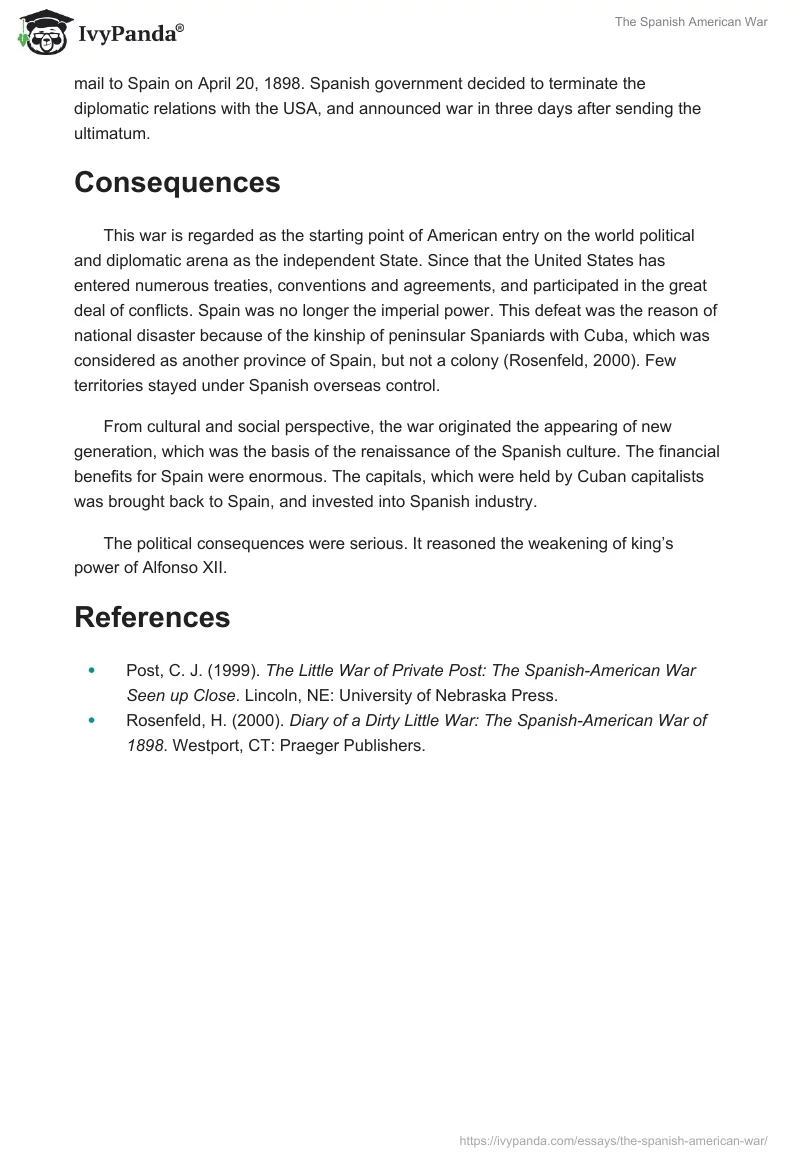Reasons and Background of the War
The Spanish American War started in 1898, and the reason of this conflict was the liberation of Cuba. The war started after Spain’s rejection of the American request for the resolution of the Cuban struggle for independence. The expansionist sentiment within the US government, and the imperialistic moods of American political tradition motivated the government to work out the plan for separating Cuba from Spain (The annexation plan also included Philippines, Puerto Rico, and Guam).
The starting point of the conflict was the revolution in Cuba. After that events the US government sent in the warship USS Maine, which revealed the immense political interest of the United States in that region. The American tabloids accused Spain of the oppression in the Spanish colonies.
Originally, the Spanish-American War was started for a great deal of reasons. It is emphasized that the most important reasons are treatment of the Cuban people by the Spanish government, yellow journalism, business interests and the fact that the United States government wished to flex its muscles as a world power (Post, 1999). The starting point of the conflict was the sinking of US battleship Maine in Havana harbor February 15, 1898. The US claimed that Spanish government is guilty for this sinking, however, it has not been proven. The United States were not prepared for this war, and according to logic the war should be lost by US troops. There was shortage in everything except volunteers, as the agitation, held by yellow journalism, was immense.
While congress was convening and accepting the resolutions which supported Cuban independence, Senator Henry M. Teller of Colorado offered the amendment which was aimed at ensuring that the United States is not wishing to set up the permanent control over Cuba after the cessation of hostilities from Spain. The Amendment was accepted, however, the resolution required immediate Spanish withdrawal, and it included the point, that the US president is capable to use the military forces in the volumes, he considers sufficient to help Cuba achieve independence from Spain. President McKinley signed this resolution, and ultimatum was sent by diplomatic mail to Spain on April 20, 1898. Spanish government decided to terminate the diplomatic relations with the USA, and announced war in three days after sending the ultimatum.
Consequences
This war is regarded as the starting point of American entry on the world political and diplomatic arena as the independent State. Since that the United States has entered numerous treaties, conventions and agreements, and participated in the great deal of conflicts. Spain was no longer the imperial power. This defeat was the reason of national disaster because of the kinship of peninsular Spaniards with Cuba, which was considered as another province of Spain, but not a colony (Rosenfeld, 2000). Few territories stayed under Spanish overseas control.
From cultural and social perspective, the war originated the appearing of new generation, which was the basis of the renaissance of the Spanish culture. The financial benefits for Spain were enormous. The capitals, which were held by Cuban capitalists was brought back to Spain, and invested into Spanish industry.
The political consequences were serious. It reasoned the weakening of king’s power of Alfonso XII.
References
- Post, C. J. (1999). The Little War of Private Post: The Spanish-American War Seen up Close. Lincoln, NE: University of Nebraska Press.
- Rosenfeld, H. (2000). Diary of a Dirty Little War: The Spanish-American War of 1898. Westport, CT: Praeger Publishers.


